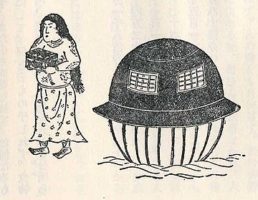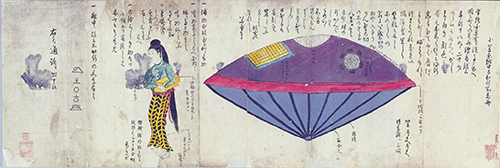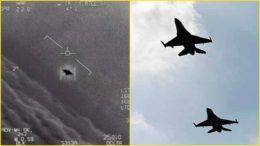by Charles Lear
 When it comes to popular culture, the Japanese people seem to have as much of an appetite for science fiction and the paranormal as the people in the United States. With stories ranging from ghosts to Godzilla to aliens, Japanese media from film to comic book has not only entertained Japanese people, but people worldwide. Despite the popularity of otherworldly subjects in that country, the Japanese government and its people have a history of being conservative regarding the subject of UFOs. According to journalist and television producer Michi Saito, “to most of the Japanese, they’re accepted as more like a mysterious fantasy.” Japanese officials have only recently acknowledged a need to have some sort of official UFO policy. This comes in the aftermath of the U.S. Department of Defense’s recent release of official UFO videos. That’s not to say there haven’t been believers within official circles or that there have been no significant cases in the country. Japan’s UFO history goes back well before the 20th century and there are enough Japanese believers, researchers and enthusiasts to keep that history alive.
When it comes to popular culture, the Japanese people seem to have as much of an appetite for science fiction and the paranormal as the people in the United States. With stories ranging from ghosts to Godzilla to aliens, Japanese media from film to comic book has not only entertained Japanese people, but people worldwide. Despite the popularity of otherworldly subjects in that country, the Japanese government and its people have a history of being conservative regarding the subject of UFOs. According to journalist and television producer Michi Saito, “to most of the Japanese, they’re accepted as more like a mysterious fantasy.” Japanese officials have only recently acknowledged a need to have some sort of official UFO policy. This comes in the aftermath of the U.S. Department of Defense’s recent release of official UFO videos. That’s not to say there haven’t been believers within official circles or that there have been no significant cases in the country. Japan’s UFO history goes back well before the 20th century and there are enough Japanese believers, researchers and enthusiasts to keep that history alive.
There are alleged reports from as early as 1015 that have been passed from author to author and all around the internet. They’re interesting but they lack any reference to an original source from the period, or at least, one that can be found by a shameless armchair researcher. One report, however, does come with an original source citation, and an explanation as wonderfully ridiculous as some of those offered by our modern debunkers. From the book, “Azuma Agami” a chronicle covering the years 1180 to 1266, comes a UFO report that was investigated by what could loosely be called, “scientific consultants.” On October 2, 1235, Shogun, Yoritsune Suketoshi, reported that strange lights had been seen in the southwest, swinging and circling. He ordered his astrology consultants, who had a good knowledge of astronomy, to investigate. After consideration, they reported that the cause of the strange light activity was the wind causing the stars to sway.
 Another ancient episode brought up by UFOlogists is known as the “Utsuro-bune” incident, which, according to legend, took place on February 22, 1803. Utsuru-bune translates to “hollow boat” and it refers to a vessel that washed up on a beach in Hitachi province. Inside was a woman with red hair who spoke a strange language. No one was able to communicate with her so she was returned to the sea. The description of the boat mentions wood and tree resin, which seems to make it a poor candidate for a spaceship.
Another ancient episode brought up by UFOlogists is known as the “Utsuro-bune” incident, which, according to legend, took place on February 22, 1803. Utsuru-bune translates to “hollow boat” and it refers to a vessel that washed up on a beach in Hitachi province. Inside was a woman with red hair who spoke a strange language. No one was able to communicate with her so she was returned to the sea. The description of the boat mentions wood and tree resin, which seems to make it a poor candidate for a spaceship.
In the modern era, reports from the late 1940s, beginning in 1947, can be found using the chronology index on the N.I.C.A.P. website. Most reports are of not-so-dramatic radar returns but one, involving visual observation, came from a USAF pilot flying out of Misawa AFB, Honshu, who, on May 31, 1949, saw a fast moving disk disappear into a cloud. A more dramatic USAF encounter occurred on March 29, 1952 and made the news in January of 1953. Lt. David C. Brigham reported that at 11:20 AM, while flying a propeller driven reconnaissance plane over northern Japan, an F-84 Thunderjet pulled up alongside. To the right of and just behind the jet was a small metallic disk that was going faster than the jet. According to Brigham in his report to intelligence officers:
“It closed rapidly and just before it would have flown into his fuselage, it decelerated to his air-speed almost instantaneously. In doing so, it flipped up its edge at approximately a 90-degree bank. Then it fluttered within 20 feet of his fuselage for perhaps two or three seconds, pulled away and around his starboard (right) wing, appearing to flip once as it hit the slipstream behind his wing tip fuel tank.”
Over the Ryukyu Islands, at 2:30 PM, on or about March, 24th, 1955, a pilot instructor and student in a private one-engine Beechcraft airplane, reported an encounter with a hat-shaped craft that had what looked like three windows. The craft changed colors, switching between orange and white and flew all around the plane as if it were examining it. The plane’s instruments stopped working and the panicked pilot went into a dive in an attempt to escape but the object remained with the plane until two jets were sent up to investigate.
A land-based report involving Japanese civilians is dated August 20, 1957. On a beach in Fujisawas City, Shinichi Takeda and his sister spotted a silvery object and managed to take a photo of it.
A report from the 1960’s seems like a foreshadowing of what is perhaps the most famous Japanese UFO case, the 1986 encounter involving JAL flight 1628, which will be covered further on. On March 18, 1965, Yoshiaki Inada, pilot of a Toa Airlines plane with 40 passengers, reported that an elliptical luminous object paced his plane for 55 miles. During this time, he told news reporters, his radio and direction finder were “violently” affected.
In the 1970’s, the northernmost island of Hokkaido was the location of multiple sightings, with two involving photos and one that involved the observation of human entities. The last case was reported to the chairman of the Modern Space Flight Association, Junichi Takahashi, who was also the Japanese representative of the Aerial Phenomena Research Organization. In July of 1973, the anonymous witness reported seeing a metallic craft with windows hovering over the water. Behind the windows, he could see shadowy figures that were “too small and deformed to be called the shadows of men.” Then a tube came out of the bottom and appeared to be sucking up water. While this was happening, the music that had been playing on the witness’ radio was replaced by white noise.
As mentioned above, the JAL 1628 Incident is well known, especially among UFOlogists. On November 17, 1986, Captain Kenju Terauchi, co-pilot Takanori Tamefuji and flight engineer Yoshio Tsukuba all reported seeing two objects 2000 feet below them while flying over Alaska. They were on one leg of their journey from Paris to Narita International Airport with a cargo of Beaujolais wine. The objects suddenly shot up to a position between 500 and 1000 feet in front of the plane, and then seemed to fire a reverse thrust to achieve the same speed as the plane. Terauchi reported feeling heat from the objects at this point. The objects were described as being square with two rectangular arrays of lights that appeared to be thrusters. The objects left about four minutes later and disappeared below the horizon. Terauchi then noticed a band of light at his 10 o’clock position and confirmed there was an object there by using the onboard radar. The object kept pace with them and as they flew over Fairbanks, the lights allowed Terauchi to perceive an outline and he estimated the object to be twice as big as their Boeing 747. The object appeared on FAA and Air Force radar and Terauchi got FAA approval to perform evasive maneuvers. After a descent from 35,000 ft to 31,000 ft, a 45º turn and then a 360º turn, the object, described as walnut-shaped, stayed with them. As indicated by FAA flight control reports, the object followed the plane for 32 minutes and then left before the plane landed safely in Anchorage. Terauchi was assigned to a JAL desk job for several years after talking to reporters about the incident while in uniform.
 Recent news from Japan reports on that country’s Defense Ministry policy regarding UFO encounters. Reacting to the U.S. DOD’s release of official UFO videos, the ministry made a decision to create protocols and procedures to respond to, record and report UFOs. Defense Minister, Tara Kono stated, “No SDF (Self-Defense Force) pilot has encountered a UFO. The videos have come from the U.S. Defense Department so I would like to hear their analysis. I don’t really believe in UFOs. We would like to establish procedures in the event an encounter takes place with a UFO.”
Recent news from Japan reports on that country’s Defense Ministry policy regarding UFO encounters. Reacting to the U.S. DOD’s release of official UFO videos, the ministry made a decision to create protocols and procedures to respond to, record and report UFOs. Defense Minister, Tara Kono stated, “No SDF (Self-Defense Force) pilot has encountered a UFO. The videos have come from the U.S. Defense Department so I would like to hear their analysis. I don’t really believe in UFOs. We would like to establish procedures in the event an encounter takes place with a UFO.”
Not all government officials have been disbelievers, however. A 2007 Chicago Tribune article quoted former Chief Cabinet Secretary Nobutaka Machimura as saying he “definitely” believed UFOs exist. Machimura was talking to reporters about a demand from an opposition lawmaker for an inquiry into “frequent reports of UFO sightings.” The government reply was that they had “not confirmed sightings of unidentified flying objects believed to be from outer space.” After Machimura’s statement “the reporters erupted with laughter.”
Another Japanese political figure who faced up to such laughter was the wife of former Prime Minister-elect, Yukio Hatoyama. Miyuki Hatoyama wrote in her 2008 book, “Very Strange Things I’ve Encountered” that while her “body was asleep” her “soul rode on a triangular-shaped UFO and went to Venus.” Oddly, her statement doesn’t seem to have had a significant effect on official policy.